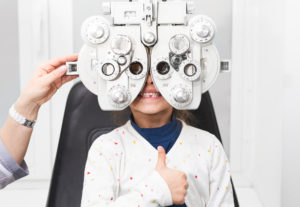July 5, 2023
By Geetha Sravani, BOptom, MBA, FAAO, PhD Candidate, BHVI

Accurate diagnosis of myopia is crucial for appropriate clinical management. It is also important for epidemiological studies on refractive errors and clinical trials related to myopia treatment. However, accommodative responses often interfere with refractive error measurements during clinical evaluation, which can lead to an overestimation of myopia and an underestimation of hyperopia.
To address this issue, cycloplegia with 1% cyclopentolate eye drops is commonly used, and cycloplegic autorefraction is considered the gold standard for accurate refractive assessment. Nevertheless, the use of cyclopentolate presents drawbacks, including visual disturbances, drowsiness, and potential ethical concerns. Senoo et al. aimed to determine the optimal cut-off spherical equivalent for diagnosing myopia and estimating its prevalence in school-aged children by analyzing case-control data obtained from medical records of children who underwent autorefraction with and without the instillation of 1% cyclopentolate eye drops. Myopia was defined as a spherical equivalent (SEQ) of -0.50D or less measured through cycloplegic autorefraction.
A total of 232 children (mean age: 8.2 years, ranging from 6 to 12 years) were included in the study, with 126 boys (54.3%) and 116 children (50.0%) diagnosed with myopia. In diagnosing myopia, the receiver operating characteristic (ROC) curve and diagnostic performance (DP) plots were used to determine the optimal cut-off value for non-cycloplegic autorefraction. The authors found that an SEQ cut-off of -0.75D yielded a sensitivity of 90.5% and specificity of 95.7% for myopia diagnosis.
However, the DP plots revealed that the optimal cut-off value varied significantly depending on the prevalence of myopia. Specifically, for prevalence rates of 30%, 50%, and 80%, the cut-off SEQ values were -1.31D, -0.81D, and -0.65D, respectively. The study also identified higher accommodation in children aged 6 years and those with hyperopic eyes (p < 0.001) during non-cycloplegic autorefraction.
In conclusion, relying solely on non-cycloplegic autorefraction with a theoretical cut-off SEQ of -0.50D would result in an overestimation of myopia prevalence. Therefore, the authors recommend setting the cut-off value lower (more myopic) when diagnosing myopia using non-cycloplegic autorefraction, particularly in younger children with a low prevalence of myopia.
Abstract
The Optimal Cut-Off Value of Non-Cycloplegic Autorefraction for Diagnosing Myopia in School-Aged Children
Yuki Senoo, Takashi Furuse, Satoshi Hasebe
Purpose: To determine the optimal cut-off value of non-cycloplegic autorefraction for diagnosing myopia and estimating myopia prevalence in school-aged children.
Study design: Retrospective case-control study.
Subjects and methods: Based on age and sex, case-control data were extracted from the medical records of children who underwent autorefraction before and after instillation of 1% cyclopentolate eye drops. We regarded a spherical equivalent (SEQ) of -0.50 D or less found by cycloplegic autorefraction as myopia and determined the optimal cut-off value of non-cycloplegic autorefraction for diagnosing myopia using a receiver operating characteristic (ROC) curve and diagnostic performance (DP) plots.
Results: Of a total of 232 children (mean age 8.2 [range: 6-12] years, 126 boys [54.3%]), 116 (50.0%) had myopia. In this cohort, the optimal cut-off SEQ for diagnosing myopia was -0.75 D with a sensitivity of 90.5% and specificity of 95.7%. However, the DP-plots indicated that the cut-off value significantly varied with prevalence of myopia: -1.31 D, -0.81 D, and -0.65 D for the prevalence of 30%, 50%, and 80%, respectively. For non-cycloplegic autorefraction, we found greater accommodation in children aged 6 years and hyperopic eyes (p < 0.001).
Conclusion: When diagnosing myopia using non-cycloplegic autorefraction alone with a theoretical cut-off SEQ of -0.50 D, the prevalence of myopia will be overestimated, and we need to set the cut-off value lower (more myopic), especially in younger children with low prevalence.
Senoo, Y., Furuse, T., & Hasebe, S. (2022). The optimal cut-off value of non-cycloplegic autorefraction for diagnosing myopia in school-aged children. Japanese Journal of Ophthalmology, 66(5), 455-460.
DOI: https://doi.org/10.1007/s10384-022-00928-x
 |
Geetha Sravani is a PhD candidate at the Brien Holden Vision Institute, supervised by Prof. Padmaja Sankaridurg and Arthur Back. Her research focuses on the role of pupillary responses in myopia. |













